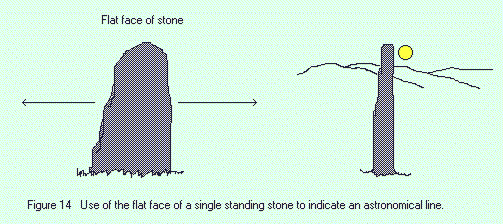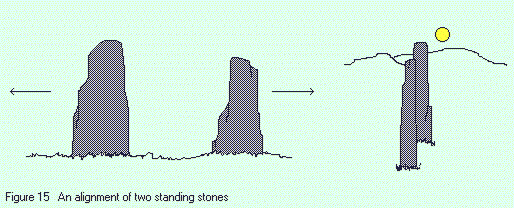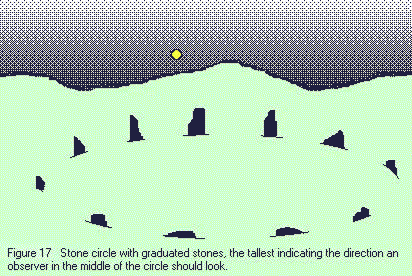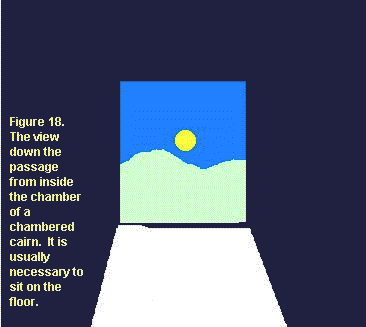
The Monuments
Stones
of Wonder
QUICK LINKS ...
HOME PAGE
INTRODUCTION
WATCHING
THE SUN, MOON AND STARS
THE
MONUMENTS
THE
PEOPLE AND THE SKY
BACKGROUND
ARCHAEOASTRONOMY
USING
THE SITE DESCRIPTION PAGES
VISITING
THE SITES
THE
LEY LINE MYSTERY
THE
SITES
ARGYLL
AND ARRAN
MID
AND SOUTH SCOTLAND
NORTH
AND NORTH-EAST SCOTLAND
WESTERN
ISLES AND MULL
Data
DATES
OF EQUINOXES AND SOLSTICES, 1997 to 2030 AD
DATES
OF MIDSUMMER AND MIDWINTER FULL MOONS, 1997 to 2030 AD
POSTSCRIPT
Individual
Site References
Bibliography
Links
to other relevant pages
Contact
me at : rpollock456@gmail.com
The sites which feature in this Web guidebook are
a) standing stones, set singly or in alignments
b) stone circles and
c) chambered cairns.
These sites have many things in common. The most significant thing of all is that they belong to the prehistoric period. In other words, there are no contemporary written accounts of their erection or usage. This is true for western Europe as a whole, where similar structures occur. (In fact here are no written sources at all referring to Scotland until the 1st century A.D., when the Roman army arrived, and even thereafter records are very rare until about the 12th century A.D.).
The monuments are also very numerous, there being hundreds of each kind recorded in the databases of the National Monument Record of Scotland. They all feature large stones (megaliths) in their construction, and they have all been placed by archaeologists in the Neolithic and Early Bronze Ages, and so date to between about 4000BC and 1500BC. (Where a more precise dating is available for a particular site, it is mentioned in the individual site page).
The chambered cairns, often called 'chambered tombs' or 'passage graves', and stone circles are usually interpreted as belonging to the Neolithic period, and the single stones and alignments, as a class, to the Bronze age. It is often found on excavation also that a particular site has been used and re-used over a very long period - such striking and permanent structures being added to, reconstructed or used for different purposes over the prehistoric centuries. However, the vast majority of the sites have not been excavated in modern times using modern methods and a precise date of first construction and details of subsequent use are therefore not known.
So the stones keep their secrets, and retain an air of mystery which is often palpable to a visitor and adds to their attraction. Because the chambered cairns, the standing stones and circles are prehistoric, and no definitive account of their purpose exists (compared with, say, the Antonine wall) speculation as to their use and meaning has been rife.
The chambers of the cairns often contain human bones, or carbonised bone, and so they have obviously been used as burial places. By extension, the standing stones have been held to mark the graves of warriors or kings and queens. But it is apparent even to a casual visitor that a monument like Maes Howe on Orkney or any of the recumbent stone circles of Grampian could have had many purposes, of which burial would have been only one, in the same way as the churches of a later era would have many uses, of which burial was one, but not the most important. It should be borne in mind that this Web guide deals mainly with one aspect of the use of such prehistoric sites, their astronomical function. Information about this is recovered by site survey. But such sites are the mere physical remains of no doubt rich and complex belief systems which are not recoverable at all.
Standing stones
More single standing stones feature in this guide than any other kind of ancient site. They are usually dated by archaeologists to the Early Bronze Age (about 2000BC), partly because they are sometimes set up in association with kerb cairns which have been dated to this period. Some standing stones may be earlier, however, and so date to the Neolithic period. This may particuarly be true of the cup-marked stones [Burgess 1990. This paper presents telling arguments that cup and cup-and-ring markings belong to the Neolithic period only]. Excavation of the sockets of such stones is rarely done and seldom provides any dating evidence.
Standing stones can vary from 1.5 metres to 4 metres tall, and often have two long flat faces, or sides. It is the flat faces which usually indicate the directions to look towards the horizon (figure 14).

The stones are usually of local rock, and can vary from squat blocks to tall thin slabs. As well as astronomical markers, some stones have been interpreted as battle memorials, route markers or indications of territorial boundaries. In some cases these interpretations may be correct, and many stones do not have any astronomical function. Some stones may also mark burials, but the area around most stones have never been excavated. (The carved Pictish stones belong to a much later period. But the Picts occasionally made carvings on standing stones of the Neolithic or Bronze ages, presumably to save the trouble of erecting a new stone).
Standing stones are sometimes grouped in a line of two or more, and are then referred to as 'alignments'. Often, but not always, the longer sides or faces of the stones in the alignments are set on the same axis, so giving a convincing indication of the directions for an observer to look in (figure 15).

There are many standing stones in Scotland, for example the giant one at Beacharr on the west coast of Kintyre, which have no apparent axis, no flat sides or faces which could lead an observer to look towards a point on the horizon. Such stones may have lost their partners in a pairing of stones, or in an alignment; but they may also have had other purposes and do not generally feature here. Some surveyors have speculated that stones like this may simply mark the place to stand to watch the sun or moon rise or set over a known, unindicated, horizon point. This may or may not be true, but since there are so many unequivocally orientated standing stones to visit in Scotland, the doubtful ones will only be mentioned in passing.
Stone Circles
There are hundreds of stone circles in Scotland, but unfortunately only a few are in a good state of preservation. Often many of the original stones have fallen or have been removed entirely. The height of the stones used can vary widely, even in the same area. Stone circles are often associated with 'henges', which consist of a ditch and an outer bank around the circle. When henges are excavated, they sometimes give evidence that a ring of wooden posts stood within them ; one such site at Balfarg in Fife gave a radiocarbon date close to 3000BC. An excavation at the henge around the stone circle at Stenness on the Orkney mainland yielded animal bone which gave a date only slightly younger. Circles may have continued to be erected until about 1500BC.
Unlike the single standing stones, the circles are concentrated in particular areas of the country - the Hebrides, Perthshire, the north-east, and the south-west. Often such concentrations are of a particular type of circle. In the Aberdeen area the 'recumbent stone circles' are striking monuments which include a massive boulder lying flat as part of the circle, and which usually enclose a 'ring cairn' - a low ring of stones or earth with a clear space in the centre. Around Inverness the Clava-type cairns have freestanding circles of stones around them. On Arran there is a unique grouping of circles very close together on Machrie moor, many of which combine tall sandstone slabs and squat boulders. The circles on Lewis include one at the famous site of Callanish, the most awe-inspiring prehistoric monument in Scotland, which also features an avenue of stones leading towards the circle.
Archaeologists dislike the term 'ritual site', but it is often applied by them to stone circles. Their purpose is much less easy to grasp than a house or a fort. Circles are often interpreted as a way of defining a sacred area, separate from the ordinary world, for the performance of ceremonies under the open sky. Burials are often found in circles, but may date to a much later period than the erection of the stones. The use of stone circles for ritual and ceremonial is of course not incompatible with their erection as permanent orientations to the sun or the moon. As an analogy, Christian churches were formerly always set with the nave lying east to west, and sometimes with an orientation towards sunrise on the patron saint's feast day.
It is legitimate to ask how a circle of stones could be used to indicate a particular horizon point and so an astronomical event? The best known ancient astronomical setting in England, the circle at Stonehenge in Wiltshire, gives some idea of how this can be done. Observers in the middle of the circle look towards a monolith set up outside the circle, the Heel stone, which marks the rising point of the sun at midsummer. So an external stone would be one way of marking a line (figure 16).


Another way which the prehistoric people used was to grade the stones in height, so that the tallest stone of the circle indicates the direction an observer should look (figure 17). This is done in the Clava sites, around Inverness. Another method was to use a large recumbent block, set between the largest stones of the circle, which an observer in the middle of the circle could look over to see the sun or moon on the horizon ; this is done at the recumbent stone circles around Aberdeen. There are sites of all these types featured here.
Chambered cairns
These occur all over Scotland, and conform to a basic design, although the form will vary from place to place. A large pile of stones or stones and earth covers a roofed internal chamber built of large stone blocks. The chamber is usually small in relation to the size of the mound. Access to the chamber is through a passage, usually straight and built of stone. Often a modern visitor will find access to the chamber is through the top of the mound. This is because when the prehistoric people were finished with their use of a cairn they would block the entrance to the passage and hide it, so that the cairn appeared to be only a pile of stones ; then treasure hunters in later periods would dig down through the top of the cairn and so get into the chamber that way. In other cases the chambers have collapsed, or much of the cairn material has been robbed out for use in building dykes or roads, so that the chambered cairn is not in its original form. In very few cases do the monuments survive as the builders left them, and a visitor must try to recreate the awe such cairns must once have produced, as the only sizable human structures in an wild environment of forest, hill and bog.
Chambered cairns are the most visible remains left by the first farming communities in Scotland. These Neolithic farmers had a settled way of life which replaced that of the dispersed and tiny hunting and gathering or Mesolithic peoples who inhabited the land for millennia before. The cairns were built widely in Europe from around 4000B.C. onwards. They have been seen by archaeologists as collective tombs, holding the bones or ashes of many generations, and often the remains of dozens of individuals are recovered from the chambers. Other interpretations see them in addition as permanent statements of land ownership by a kinship group and tribal rallying points.
Much work has been done in Scotland on the form and distribution of the chambered cairns [Henshall, 1963 and 1972], and five main groups have been distinguished, belonging to different areas of the country. Examples from the Orkney-Cromarty-Hebridean cairn type and the Clava type feature here.
 With
the chambered cairns, the viewing point for an observer is taken to be
the chamber itself, with the passage giving the line to the horizon (figure
18). The most celebrated example is in Ireland - the well known cairn
of Newgrange, on the river Boyne in Co. Meath. This has a long orientated
passage, which allows the light from the rising sun at midwinter to shine
briefly up the floor and into the chamber. This event, known to the locals
but once casually dismissed as a 'jumble of nonsense' by a professor of
archaeology is now witnessed by dozens of people (present by invitation
only) and reported by a media circus every year.
With
the chambered cairns, the viewing point for an observer is taken to be
the chamber itself, with the passage giving the line to the horizon (figure
18). The most celebrated example is in Ireland - the well known cairn
of Newgrange, on the river Boyne in Co. Meath. This has a long orientated
passage, which allows the light from the rising sun at midwinter to shine
briefly up the floor and into the chamber. This event, known to the locals
but once casually dismissed as a 'jumble of nonsense' by a professor of
archaeology is now witnessed by dozens of people (present by invitation
only) and reported by a media circus every year.
It is worth remembering that simple pre-literate subsistence societies almost always hold the sun and the moon as deities, and that such an event, the observation of the rising midwinter sun from the dark and cold interior of a chambered cairn, would have held a meaning and significance far beyond our modern appreciation.
Return to Stones of Wonder opening page